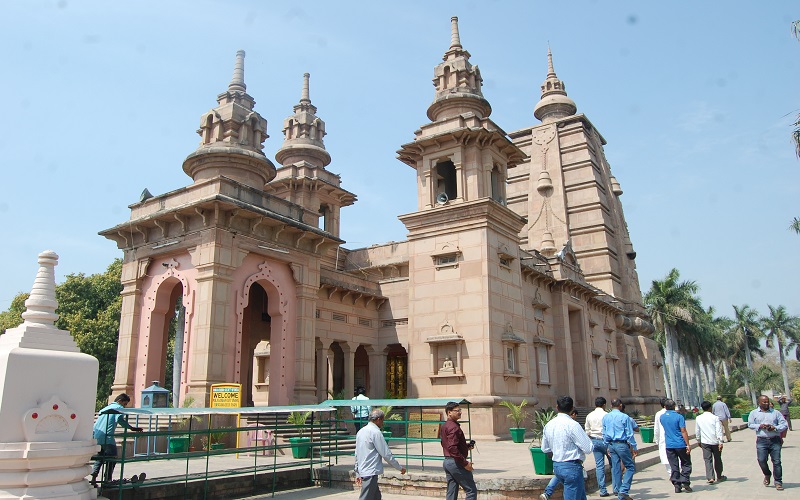
Sarnath is located 15 kms from Varanasi main market. After attaining enlightenment at Bodh Gaya Lord Buddha came to Sarnath and preached his first discourse in the deer park to set in motion the ‘Wheel of the Dharma’. There is also a Bodhi Tree planted by Anagarika Dharmapala which was grown from a cutting of the Bodhi Tree at Bodh Gaya.
Sarnath, the holy place, has been developed as a place of pilgrimage, both for Buddhists from India and abroad. Countries including Japan, Myanmar, Tibet, Sri Lanka & Thailand have erected temples in Sarnath in their own styles of architecture. One has the opportunity to experience an overview of Buddhist architecture from various cultures. The major attractions in Sarnath are – Mulagandha Kuti Vihar, Deer Park, Dhammek Stupa, Chaukhandi Stupa, Ashoka Pillar, Archeological and Excavation Area, Archeological Museum and The Garden of Spiritual Wisdom.
Mulagandha Kuti Vihar, a modern temple built by the Mahabodhi Society, is one of the well known attractions of Sarnath. Mulagandha Kuti Vihar is known for its intricate frescoes from Buddhist literature, by Kosetsu Nosu, a famous Japanese artist.
Dhammek Stupa is built in brick and stone during the Maurya Dynasty. It is about 43.6 m in height and 28 m in diameter, at the base. The lower part of the Dhammek Stupa is built of stone and is noteworthy for its intricate floral carvings.
Chaukhandi Stupa, a Buddhist stupa, was built in the 5th century by the Gupta Dynasty, to commemorate the visit of Lord Buddha and also his meeting with his first disciples.
Ashoka Pillar, the national emblem of India, is one of the major attractions at Sarnath. The 50 m high Pillar, carved out of stone, was built to mark the visit of Emperor Ashoka to Sarnath.
Archeological and Excavation Area of Sarnath noted for ancient Buddhist relics, which date back to the period between 250 BC to the 12th century AD. This site also comprises ruins of Buddhist monasteries that represent various tenets of Buddhism.
Sarnath Museum is famous for its rich collection of artifacts excavated from the Archeological site at Sarnath. The Archaeological Museum was built in 1910. The museum has five galleries named as Tathagata, Triratna, Shakyasimha Gallery, Trimurti and Ashutosh Gallery. The museum also has two verandas which are named as Vastumandana and Shilparatna. The museum also exhibits excavated sculptures and antiquities that can be dated back to the period 3rd century BC to the 12th century AD. The Sarnath Archeological Museum houses the famous Ashokan lion capital, which miraculously survived its 45-foot drop to the ground (from the top of the Ashokan Pillar), and became the National Emblem of India and national symbol on the Indian flag. The museum also houses a famous and refined Buddha-image of the Buddha in Dharmachakra-posture.
Garden of Spiritual Wisdom in Sarnath is located behind the Chaukhandi Stupa; the garden uses a mix of exhibits and sculptures to convey the essentials of Buddhism and Indian spirituality. An Ayurvedic herbal garden makes people aware of benefits of Ayurveda.
Thai Temple, one of the well known attractions surrounded by extensive gardens, is built in the Thai architectural style and is administered by Thai Buddhist monks.
Tibetan Temple is built in the traditional Tibetan architectural style, houses the statue of Shakyamuni, the Buddha. The Tibetan Temple is famous for its Thangksa (Tibetan Buddhist paintings) and frescoes, which are found on the walls and ceilings. Prayer wheels are yet another attraction of this temple, which release paper scrolls marked with chants when rotated clockwise.
Jain Temple has a beautiful carved structure offering unique sculpture. It is dedicated to Jain Tirthankara Shreyansnath. The Jain Temple in Sarnath was built in 1824 AD and is said to be located at the spot where Shreyansnath, the 11th Jain Tirthankara was born.
